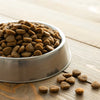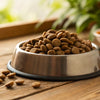How to Mix Wet Dog Food with Dry: A Comprehensive Guide for Pet Owners
- Houndsy
Table of Contents
- Introduction
- The Benefits of Combining Wet and Dry Dog Food
- How to Mix Wet Dog Food with Dry
- Tips for Mixing Wet and Dry Dog Food
- Common Concerns About Mixing Wet and Dry Dog Food
- Conclusion
Introduction
Did you know that nearly 70% of dog owners are considering mixed feeding as a way to enhance their pet's dining experience? As loving pet parents, we constantly seek ways to keep our furry companions healthy, happy, and satisfied, especially when it comes to mealtime. The choice between wet and dry dog food has traditionally divided pet owners into two camps. However, mixing wet dog food with dry is rapidly gaining popularity, blending the benefits of both worlds and allowing us to cater to our dogs' diverse needs.
In this blog post, we will explore the topic of mixed feeding and guide you on how to mix wet dog food with dry effectively. By the end, you'll understand why this practice can elevate your dog’s feeding experience, which combinations work best, and the ratios to consider. We encourage you to reflect on your own feeding routines and consider how you might enhance your dog's meals by incorporating wet food into their dry kibble.
Our main message is simple: by understanding the advantages of mixing wet and dry dog food, we can offer our dogs a more enticing and nutritious diet that meets their individual needs.
The Benefits of Combining Wet and Dry Dog Food
1. Increased Palatability
One of the primary reasons pet owners choose to mix wet and dry dog food is to boost flavor and enjoyment. Wet food is known for its rich aroma and enticing texture, making it more appealing to many dogs, especially those who may be picky eaters. By adding a spoonful of wet food to the dry kibble, we can transform a mundane meal into a gourmet experience, enticing even the most finicky of eaters.
2. Enhanced Nutritional Value
While both wet and dry dog foods offer essential nutrients, they have distinct benefits. Dry dog food is often more calorie-dense, while wet food is typically richer in moisture content. Mixing the two allows us to provide a balanced diet that meets our dog’s nutritional needs while also adding variety. According to the Pet Food Institute, dry dog food contains about 10-12% moisture, while wet formulations can be composed of 75-78% water. This hydrating aspect can be especially beneficial for dogs prone to urinary issues or those who may not drink enough water.
3. Improved Hydration
Adding wet food to dry kibble can significantly enhance our dogs’ hydration levels. This is particularly important for pets that do not drink enough water, as proper hydration is crucial for overall health. Increased moisture can aid in digestion, help prevent urinary tract problems, and keep your dog's skin and coat healthy.
4. Weight Management
For dogs that need to lose weight or maintain a healthy weight, mixing wet and dry food can be a strategic approach. The higher water content in wet food can help dogs feel fuller faster, which may aid in managing their caloric intake. Conversely, for dogs that require extra calories, adding dry kibble to wet food can help increase their caloric consumption without overwhelming them with bulk.
5. Dental Health
While dry kibble is known for its dental benefits—scraping plaque and tartar off our dog's teeth as they chew—mixing in wet food can still support dental health by encouraging chewing. This balance may allow us to enjoy the benefits of both food types, promoting oral hygiene while keeping mealtime exciting.
How to Mix Wet Dog Food with Dry
1. Choose the Right Products
When it comes to selecting wet and dry dog food for mixing, quality matters. Look for high-quality brands that use wholesome ingredients and meet the AAFCO (Association of American Feed Control Officials) standards. We, at Houndsy, believe in prioritizing pet well-being and integrity in all our products, including our flagship Houndsy Kibble Dispenser, which is designed for convenience and ease of use.
2. Determine the Right Ratio
The ideal ratio of wet to dry food can vary based on several factors, including your dog’s age, activity level, and dietary needs. A general guideline is to aim for a 75:25 or 70:30 ratio of dry to wet food. For example, if your dog typically consumes one cup of dry food, you might start by adding ¼ to ⅓ cup of wet food. Adjust this ratio based on their individual preferences and health requirements.
3. Gradually Introduce the New Mix
If your dog is new to mixed feeding, it’s crucial to introduce the combination gradually. Start by adding a small amount of wet food to their dry kibble, allowing them to adjust to the new texture and flavor. Monitor their response and adjust the ratio as needed.
4. Serve in a Convenient Dispenser
To make mealtime even more enjoyable, consider using a high-quality kibble dispenser like the Houndsy Kibble Dispenser. Our dispenser not only ensures perfect portion control but also keeps the kibble fresh and easy to dispense. Its elegant design seamlessly integrates with your home decor, allowing you to elevate your dog's feeding experience.
5. Store Leftovers Properly
If you have leftover wet food, it’s essential to store it correctly to prevent spoilage. Once opened, wet food should be refrigerated and consumed within a few days. Always check for any signs of spoilage before serving.
Tips for Mixing Wet and Dry Dog Food
1. Experiment with Flavors and Textures
Dogs, like us, enjoy variety in their meals. Don’t hesitate to experiment with different brands and flavors of wet and dry food to find the perfect combination that your dog loves. Consider rotating through different types of wet food to keep their diet interesting.
2. Monitor Your Dog’s Health
Pay close attention to your dog’s health and weight when introducing mixed feeding. Regular vet check-ups can help ensure that their nutritional needs are being met and that the feeding strategy is working for them.
3. Adjust Based on Life Stages
Consider your dog’s life stage when planning their diet. Puppies may require more calories and protein, while senior dogs might benefit from lower-calorie options. Always adjust the wet and dry food ratios accordingly.
4. Use It as a Meal Topper
If you're unsure about committing to a full mixed feeding routine, try using wet food as a topper for dry kibble. This method allows you to offer a little excitement without drastically changing their diet.
5. Consult with Your Veterinarian
If you're uncertain about the best approach to mixed feeding for your dog, consult your veterinarian. They can provide personalized recommendations based on your dog's health, dietary needs, and lifestyle.
Common Concerns About Mixing Wet and Dry Dog Food
1. Will Mixing Affect Dental Health?
While wet food may not provide the same dental benefits as dry kibble, mixing the two won't necessarily harm your dog's dental health. Regular dental check-ups and cleanings are still essential for maintaining your dog's oral hygiene.
2. Does Mixing Increase Caloric Intake?
Yes, mixing wet and dry food can increase your dog's caloric intake. It's important to balance portions accordingly to avoid unwanted weight gain. Always consider the total caloric content of both food types when determining serving sizes.
3. Are There Any Risks Involved?
The primary risks associated with mixing wet and dry food relate to storage and spoilage. Ensure that any opened wet food is properly stored in the refrigerator and consumed within a few days. Mixing different brands or formulas may also lead to digestive upset if done too quickly.
4. Is It Safe for All Dogs?
Most dogs can safely enjoy a combination of wet and dry food. However, dogs with specific dietary needs or medical conditions may require specialized diets. Always consult your veterinarian if you have concerns about your dog's health or dietary choices.
Conclusion
Mixing wet dog food with dry can transform your dog's mealtime experience, enhancing both palatability and nutritional value. By understanding the benefits and best practices involved in this feeding approach, we can create a diet that keeps our dogs healthy and happy. Remember to choose quality products, determine the right ratios, and consult with your vet when necessary.
At Houndsy, we are committed to simplifying and elevating the dog-feeding experience. Our innovative products, like the Houndsy Kibble Dispenser, can help you create a beautiful and functional feeding routine that you and your dog will love.
FAQ
1. Can I mix any wet dog food with my dog's dry food?
Yes, you can mix various brands and types of wet and dry dog food. However, it's best to choose high-quality options that are complete and balanced.
2. How do I know if my dog likes the mixed food?
Observe your dog's behavior during mealtime. If they eagerly eat the mixed food and seem satisfied, it’s a good sign they enjoy it.
3. What if my dog has allergies?
If your dog has known allergies, be cautious about mixing foods. Always consult your veterinarian to ensure that the combined foods are safe for your pet.
4. Is it necessary to mix wet and dry food?
Mixing is not necessary but can provide additional benefits, such as improved hydration and palatability. It's a personal choice based on your dog's preferences and needs.
5. How should I store leftover wet food?
Once opened, wet food should be refrigerated and consumed within a few days. Ensure the can or pouch is sealed tightly to maintain freshness.












